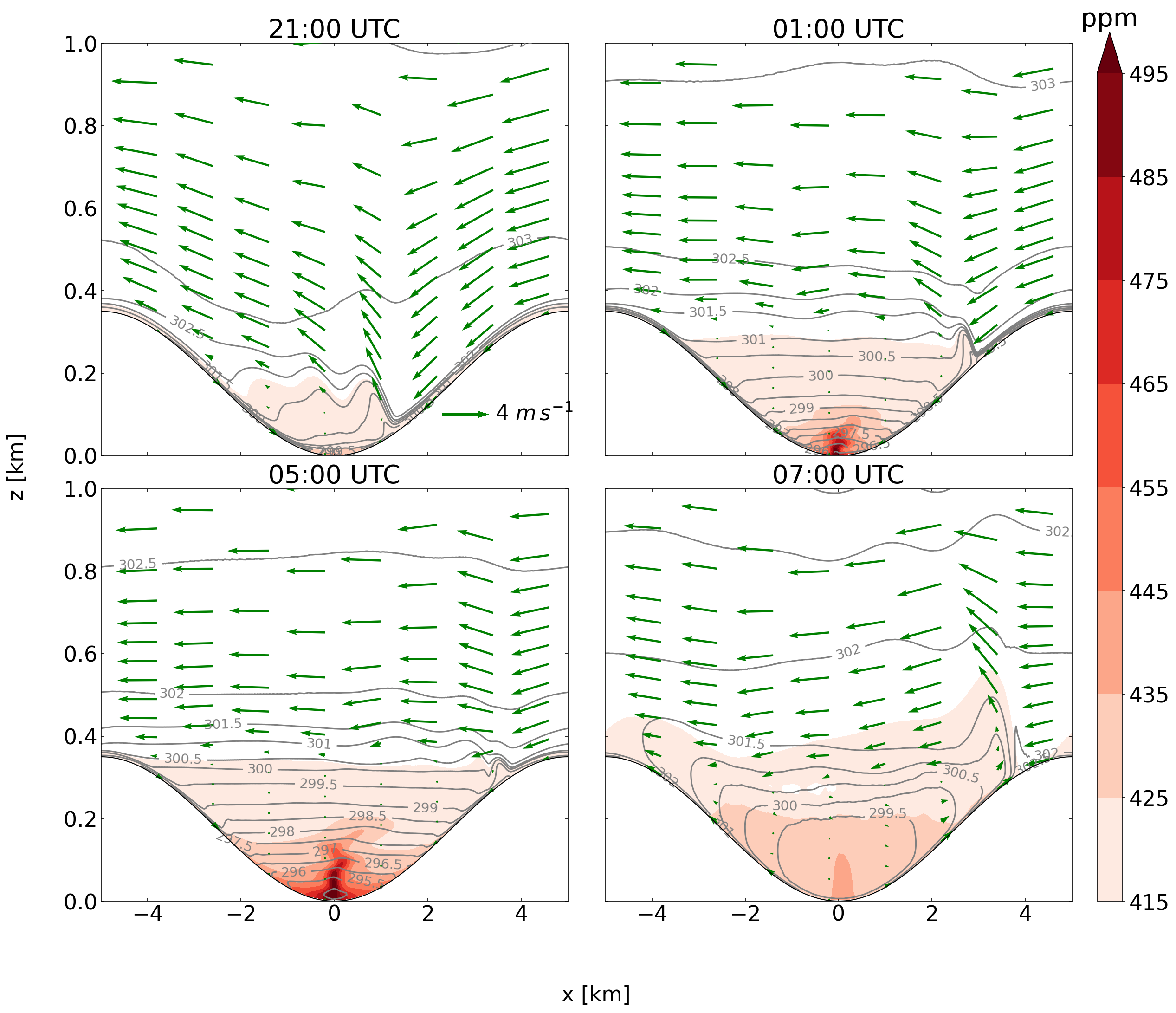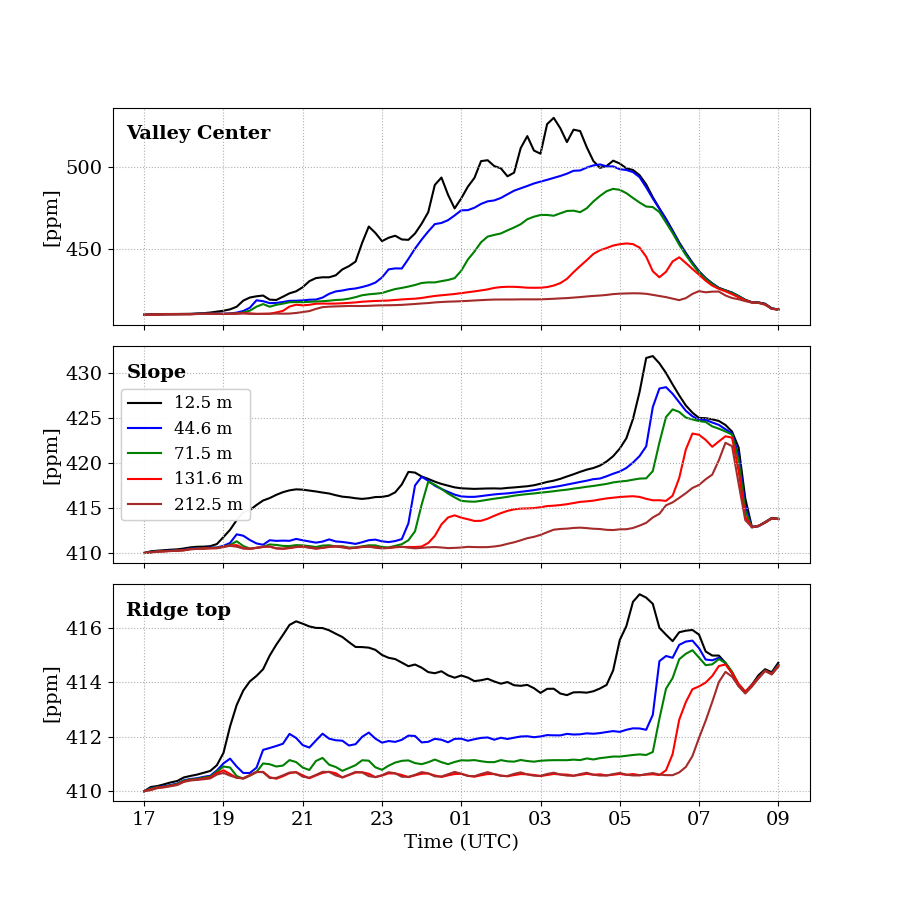Advancing the Atmospheric Modelling System of the Swiss Greenhouse Gas Emission (GHG) Monitoring System
Our work on the IG3IS project focuses on the fundamental understanding of atmospheric boundary layer processes, a cornerstone in achieving accurate trace gas simulations and inverse modeling of trace gases at regional scales. We investigate the intricacies of vertical mixing within the boundary layer and its horizontal transport by local and regional wind systems, both critical in shaping the vertical profiles of surface-emitted trace gases (like anthropogenic sources of carbon dioxide and methane). Accurate representation of these processes is of prime importance, as errors can introduce significant biases in simulated trace gas concentrations, including notable underestimations during nocturnal stable boundary layer conditions. These discrepancies may arise from various sources, such as the choice of boundary layer schemes, model numerics, like minimum diffusion coefficients, and implicit mixing effects over complex terrain. We address these issues in a combination of idealize and real-case simulations.
Idealized simulations of tracer transport in the ABL
Storage and transport processes in an idealized valley are studied using CM1 in LES mode. Multiple numerical experiments have been performed to study the effect of the background wind and grid spacing on vertical profiles, passive tracer accumulation, and flow structures. The aim of the study is to better understand the meteorology inside valleys and to offer insights for turbulence scheme developments. Our first objective is to simulate the stable boundary layer regime during a summer night in the area representative of the Swiss rolling terrain (near Beromünster). Preliminary results are shown in Figure 1 and 2.

Figure 1. Snapshot of nocturnal flow and tracer evolution in an idealized valley. Large-eddy simulation (LES) with a horizontal grid spacing of 10 m. The nocturnal accumulation of the tracer in the valley can be clearly observed, before it is dispersed by the daytime upslope winds. The following fields are shown: tracer concentration (shaded), potential temperature (gray contours), and zonal wind (green arrows).

Figure 2. Time series of tracer concentrations at three virtual towers (valley center, slope, ridge top), at five different heights for LES with dx=10m. Clearly the three sites show quite different behaviors.
Evaluation of ABL processes in ICON over Swiss Plateau:
We also perform real case ICON simulations to find an optimal model configuration for the simulation of ABL processes and thus mixing of GHGs over complex terrain. To achieve this, several case studies have been evaluated using ICON-1 (ICON with a model grid spacing of 1 km) corresponding to the pre-operational setup at Meteoswiss. The evaluation focuses mainly on the observation sites at Payerne and Beromünster. The selected periods range from summertime clear-sky fair-weather situations with a strong diurnal cycle of the GHG concentrations to a cloudy period and to persistent fog and low-level stratus over the Swiss Plateau. These periods have been simulated with different turbulence parameterization available in ICON: the operational TKE-based turbulence parameterization scheme (hereafter ICON-NWP) and our newly developed two-energies turbulence scheme (Ďurán 2018, 2022) (hereafter ICON-2TEAPDF). The initial and boundary conditions are taken from COSMO-1 analysis fields. A spatial snapshot of the downward longwave irradiance in the observation and simulated in the above experiments at 06 UTC on 14 Dec 2021 is shown in Figure 3. Unlike ICON-NWP, the ICON-2TEAPDF is able to simulate the NE-SW elongated fog layer over the Swiss Plateau. Possible reasons for the differences are discussed in Singh et al. (in progress).

Figure 3. Spatial distribution of downward LW irradiance from the (a) observation (https://navigator.eumetsat.int), (b) NWP and (c) 2TE+APDF at 06 UTC 14 Dec 2021. The black isolines enclose orography at 1000 m a.s.l. and the gray contour shows national boundary of Switzerland.
References
Ďurán, I.B., J.-F. Geleyn, F. Váňa, J. Schmidli, et al. (2018): A Turbulence Scheme with Two Prognostic Turbulence Energies, J. Atmos. Sci., 75(10) https://doi.org/10.1175/JAS-D-18-0026.1
Ďurán, I.B., M. Sakradzija, and J. Schmidli (2022): The Two-Energies Turbulence Scheme Coupled to the Assumed PDF Method, J Adv Model Earth Sy, 14(5) https://doi.org/10.1029/2021MS002922



